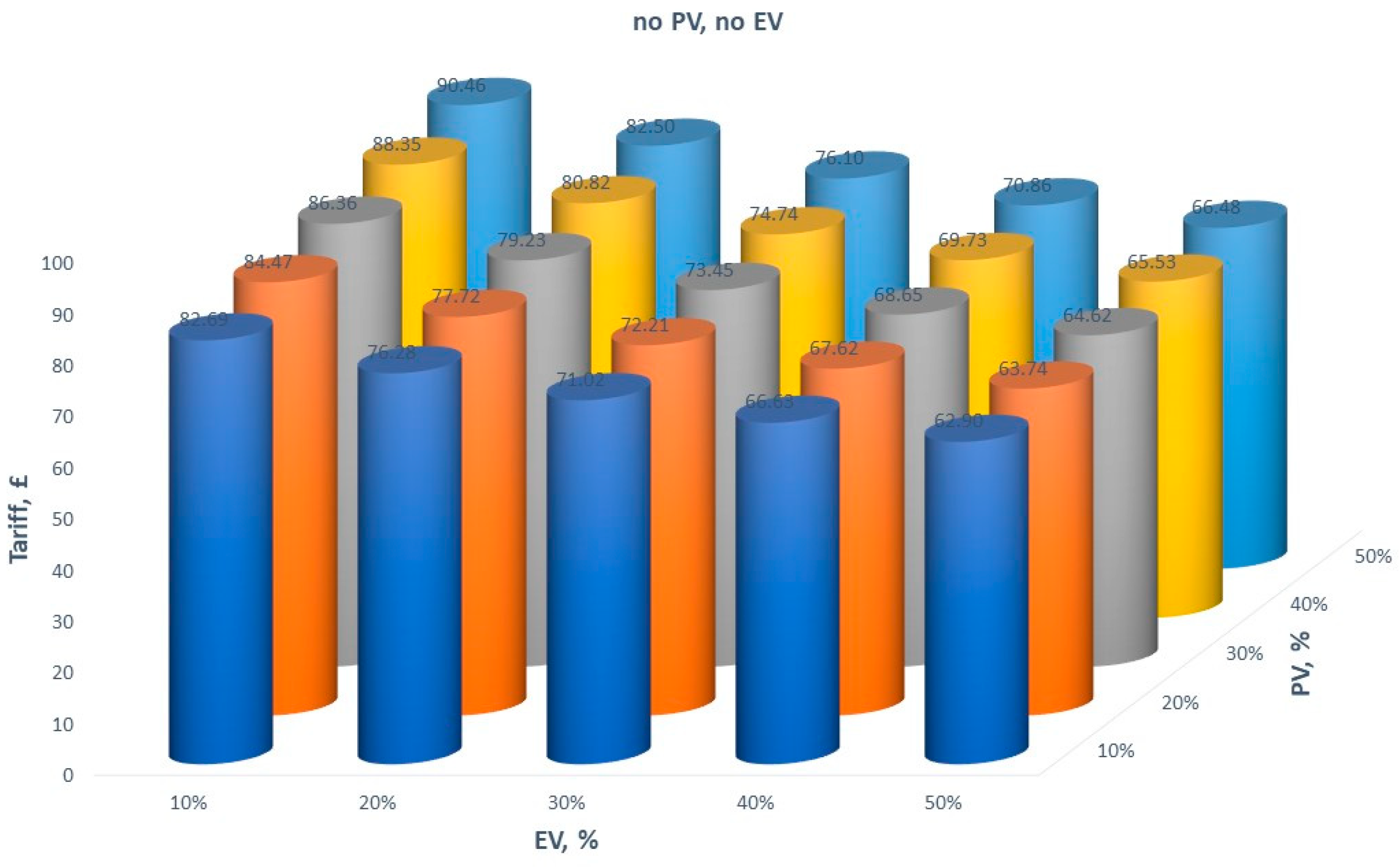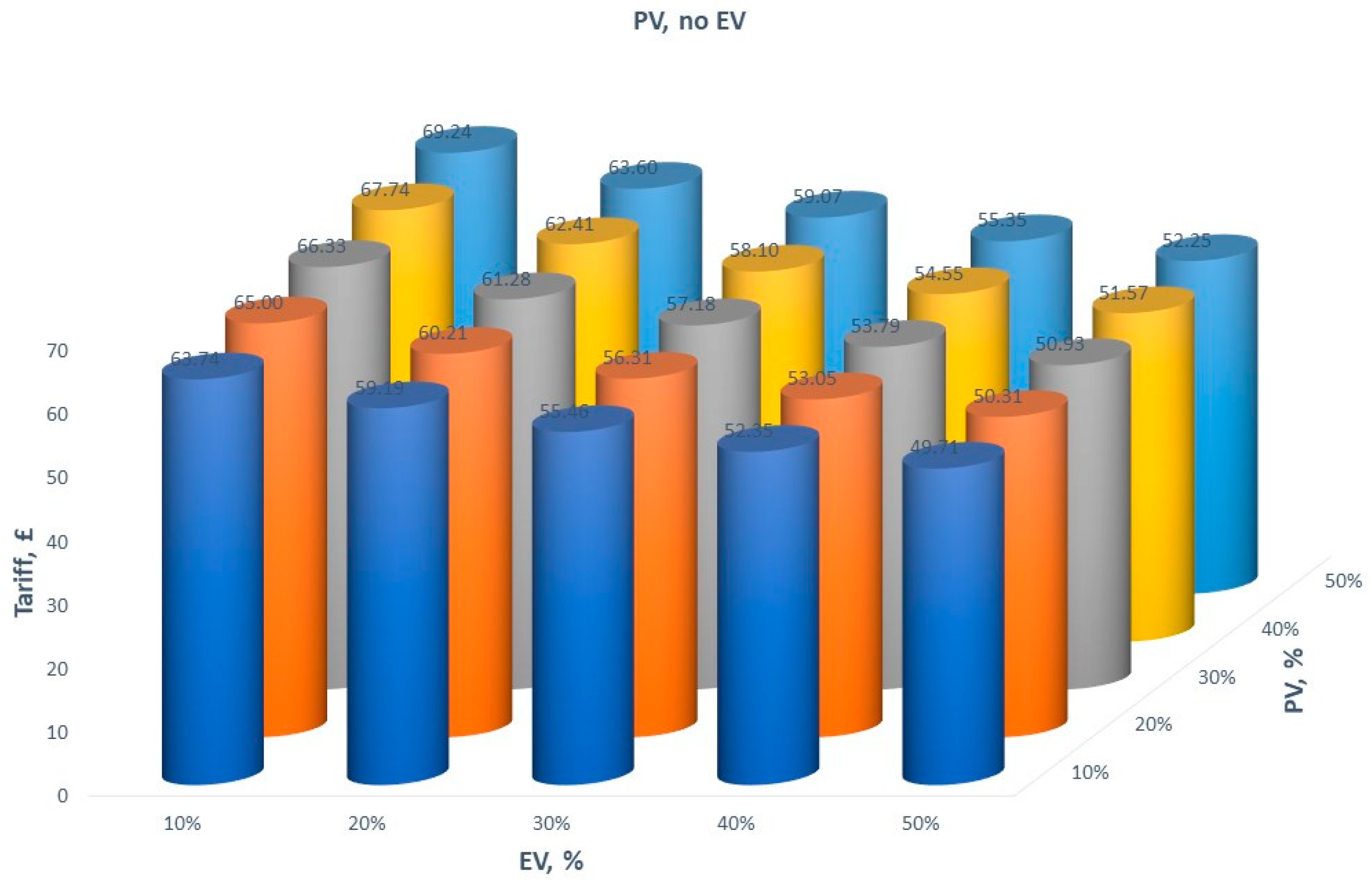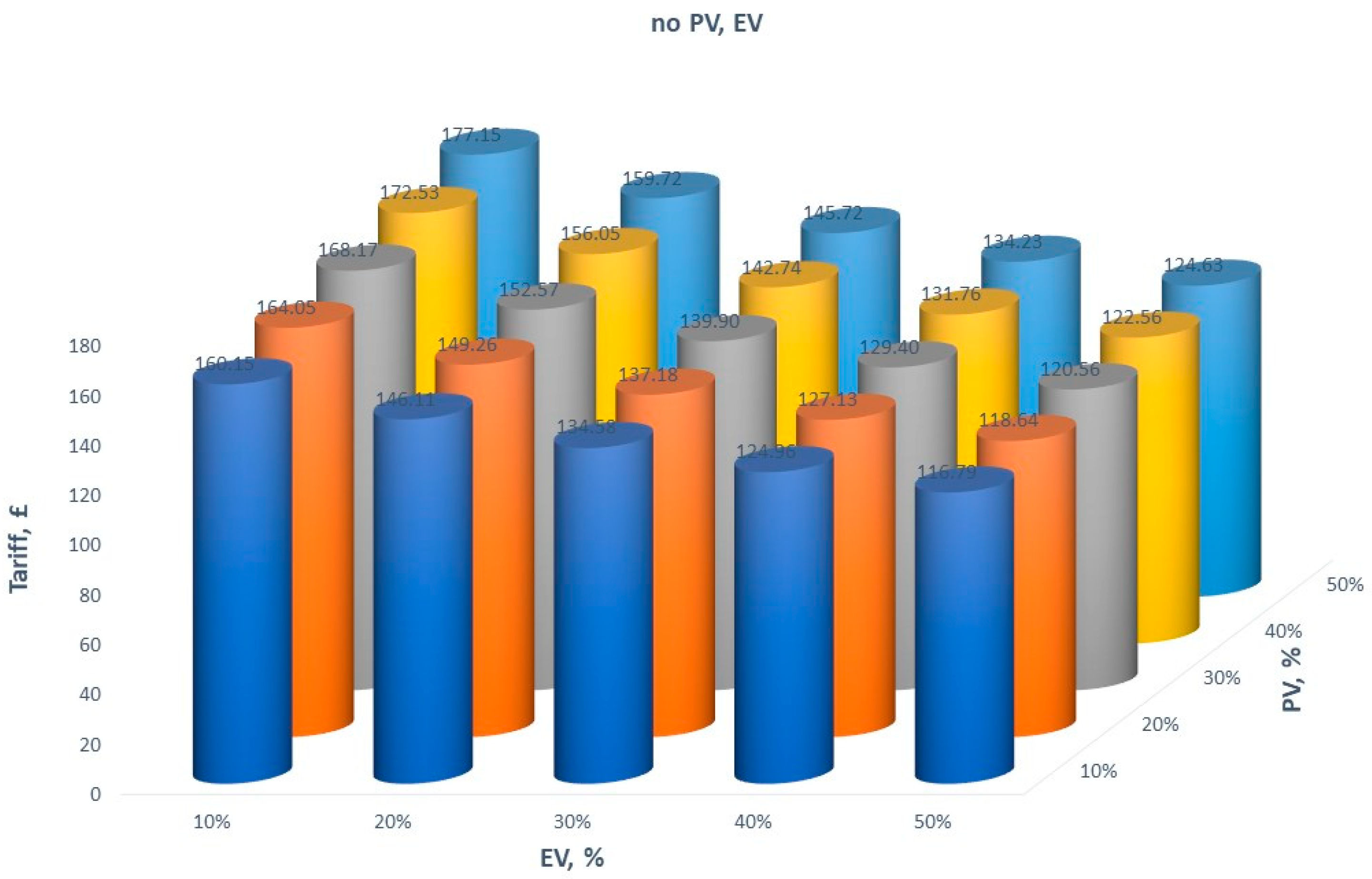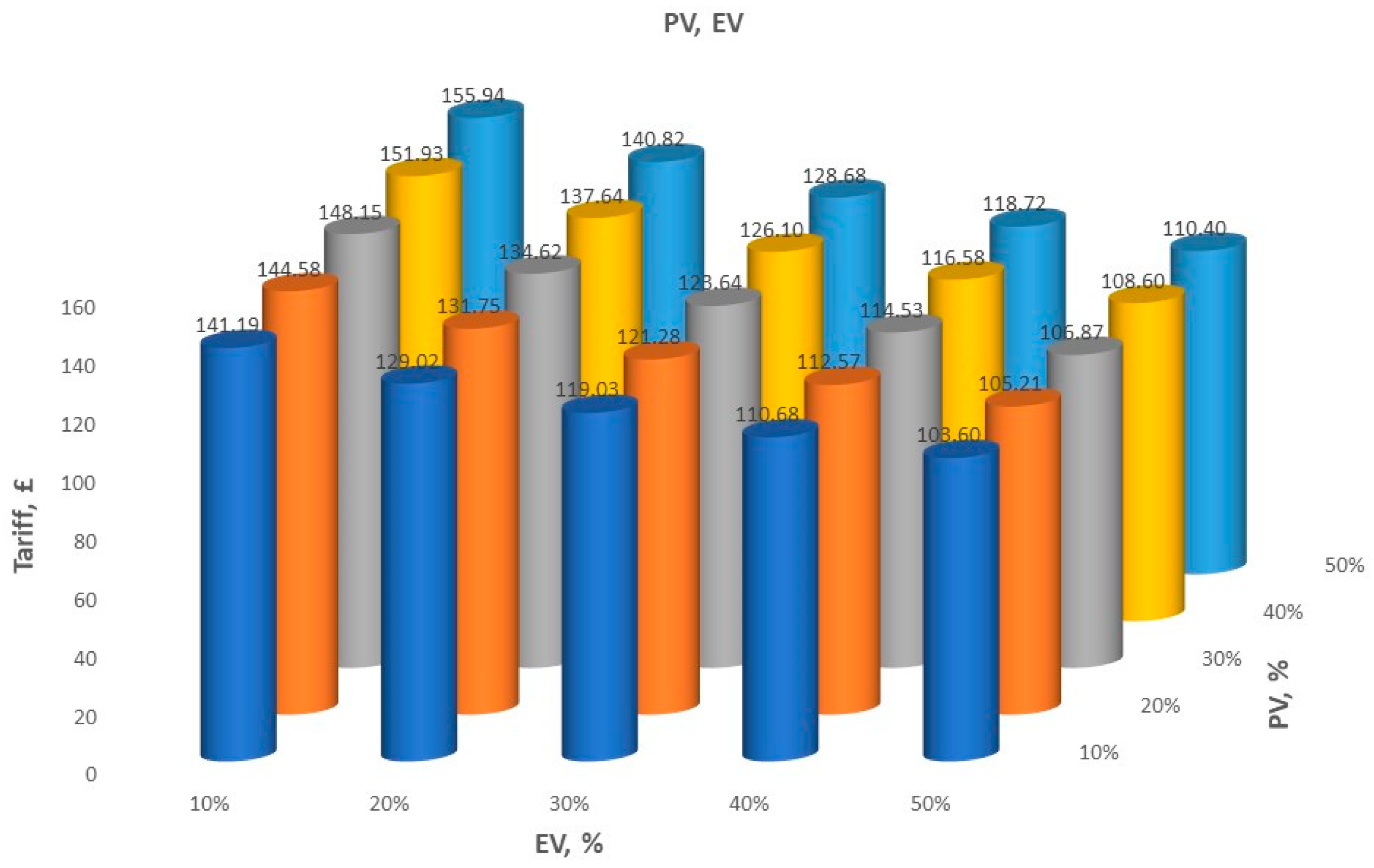Innovative Policies for Energy Efficiency and the Use of Renewables in Households
Abstract
1. Introduction
2. Innovative Policies for Promoting Energy Efficiency
3. Economic Growth and Carbon-Free Economy
4. Research Methodology and Data Description
- PV solar systems below 50 kW can use FiTs;
- PV solar systems between 50 kW and 5 MW can use both FiTs and the quota system;
- PV solar systems more than than 5 MW can use the quota system.
- There are around 23.4 million residential dwellings
- There are about 27 million residential electricity customers
- Around 61% of UK households are located in suburban areas
- About 21% are located in city or urban centres
- Around 63% are owner occupied
- Nearly 20% are private rented
5. Empirical Model
- x—an additional component that needs to be added to the existing optimal tariffs and charges in a situation when the total number of customers remains the same but the share of solar PV increases altering the total recovered revenue (expressed in £);
- F—payment for the unit of power (kW) per day by one household (k) connected to the electricity network (expressed in £);
- v—payment for the unit of energy (kWh) by one household (k) connected to the electricity network (expressed in £);
- TR—total revenue of the electricity provider for N customers (households) (expressed in £);
- Scenario 1 (no PV, no EV);
- Scenario 2 (PV, no EV);
- Scenario 3 (no PV, EV);
- Scenario 4 (PV, EV)
- tsy—a digital meter variable tariff for period y,
- Tsv—the ordered set of time-of-use tariffs;
- Ik—a set of peak and off-peak periods.
6. Discussion and Conclusions
Author Contributions
Acknowledgments
Conflicts of Interest
Abbreviations
| CLNR | Customer-Led Network Revolution |
| CO2 | Carbon dioxide (greenhouse gas) |
| ESCO | Energy service company |
| EPC | Energy performance certificate |
| EV | Electric vehicle |
| FiT | Feed-in Tariff |
| LCN | Low Carbon Network |
| PV | Photovoltaic panels |
| REC | Renewable energy certificate |
| RES | Renewable energy sources |
| SEEA | State Energy Efficiency authority |
| TIC | Total installed capacity |
| UK | United Kingdom |
References
- Li, H.; Li, F.; Shi, D.; Yu, X.; Shen, J. Carbon Emission Intensity, Economic Development and Energy Factors in 19 G20 Countries: Empirical Analysis Based on a Heterogeneous Panel from 1990 to 2015. Sustainability 2018, 10, 2330. [Google Scholar] [CrossRef]
- Newbery, D.; Pollitt, M.G.; Ritz, R.A.; Strielkowski, W. Market design for a high-renewables European electricity system. Renew. Sustain. Energy Rev. 2018, 91, 695–707. [Google Scholar] [CrossRef]
- Bel, G.; Joseph, S. Climate change mitigation and the role of technological change: Impact on selected headline targets of Europe’s 2020 climate and energy package. Renew. Sustain. Energy Rev. 2018, 82, 3798–3807. [Google Scholar] [CrossRef]
- Rausser, G.; Strielkowski, W.; Štreimikienė, D. Smart meters and household electricity consumption: A case study in Ireland. Energy Environ. 2018, 29, 131–146. [Google Scholar] [CrossRef]
- Shahsavari, A.; Akbari, M. Potential of solar energy in developing countries for reducing energy-related emissions. Renew. Sustain. Energy Rev. 2018, 31, 275–291. [Google Scholar] [CrossRef]
- Narayan, N.; Chamseddine, A.; Vega-Garita, V.; Qin, Z.; Popovic-Gerber, J.; Bauer, P.; Zeman, M. Quantifying the Benefits of a Solar Home System-Based DC Microgrid for Rural Electrification. Energies 2019, 12, 938. [Google Scholar] [CrossRef]
- Centobell, P.; Cerchione, R.; Esposito, E. Environmental sustainability and energy-efficient supply chain management: A review of research trends and proposed guidelines. Energies 2018, 11, 275. [Google Scholar] [CrossRef]
- Chang, M.-C.; Shieh, H.-S. The Relations between Energy Efficiency and GDP in the Baltic Sea Region and Non-Baltic Sea Region. Transform. Bus. Econ. 2017, 16, 235–247. [Google Scholar]
- Schandl, H.; Hatfield-Dodds, S.; Wiedmann, T.; Geschke, A.; Cai, Y.; West, J.; Newth, D.; Baynes, T.; Lenzen, M.; Owen, A. Decoupling global environmental pressure and economic growth: Scenarios for energy use, materials use and carbon emissions. J. Clean. Prod. 2016, 20, 45–56. [Google Scholar] [CrossRef]
- Kuzmin, E.A.; Volkova, E.E.; Fomina, A.V. Research on the concentration of companies in the electric power market of Russia. Int. J. Energy Econ. Policy 2019, 9, 130–136. [Google Scholar] [CrossRef]
- Pooranian, Z.; Abawajy, J.; Conti, M. Scheduling distributed energy resource operation and daily power consumption for a smart building to optimize economic and environmental parameters. Energies 2018, 11, 1348. [Google Scholar] [CrossRef]
- Lawrence, T.M.; Boudreau, M.C.; Helsen, L.; Henze, G.; Mohammadpour, J.; Noonan, D.; Patteeuw, D.; Pless, S.; Watson, R.T. Ten questions concerning integrating smart buildings into the smart grid. Build. Environ. 2016, 108, 273–283. [Google Scholar] [CrossRef]
- Franke, M.; Nadler, C. Energy efficiency in the German residential housing market: Its influence on tenants and owners. Energy Policy 2019, 128, 879–890. [Google Scholar] [CrossRef]
- Levinson, A. How much energy do building energy codes save? Evidence from California houses. Am. Econ. Rev. 2016, 106, 2867–2869. [Google Scholar] [CrossRef]
- So, K.C.; Wu, E. Developing cost-effective inspection sampling plans for energy-efficiency programs at Southern California Edison. Interfaces 2016, 46, 522–532. [Google Scholar] [CrossRef][Green Version]
- Vlasov, A.I.; Echeistov, V.V.; Krivoshein, A.I.; Shakhnov, V.A.; Filin, S.S.; Migalin, V.S. An information system of predictive maintenance analytical support of industrial equipment. J. Appl. Eng. Sci. 2018, 16, 515–522. [Google Scholar] [CrossRef]
- Alam, M.; Zou, P.X.; Stewart, R.A.; Bertone, E.; Sahin, O.; Buntine, C.; Marshall, C. Government championed strategies to overcome the barriers to public building energy efficiency retrofit projects. Sustain. Cities Soc. 2019, 44, 56–69. [Google Scholar] [CrossRef]
- Gana, J.; Hoppe, T. Assessment of the Governance System Regarding Adoption of Energy Efficient Appliances by Households in Nigeria. Energies 2017, 10, 132. [Google Scholar] [CrossRef]
- Zhu, J.; Chertow, M.R. Business strategy under institutional constraints: Evidence from China’s energy efficiency regulations. Ecol. Econ. 2017, 135, 10–21. [Google Scholar] [CrossRef]
- Zhang, S.; Jiao, Y.; Chen, W. Demand-side management (DSM) in the context of China’s on-going power sector reform. Energy Policy 2017, 100, 1–8. [Google Scholar] [CrossRef]
- Smith, H.A. Unwilling internationalism or strategic internationalism? Canadian climate policy under the conservative government. Can. Foreign Policy J. 2009, 15, 57–77. [Google Scholar] [CrossRef]
- Geller, H.; Harrington, P.; Rosenfeld, A.H.; Tanishima, S.; Unander, F. Polices for increasing energy efficiency: Thirty years of experience in OECD countries. Energy Policy 2006, 34, 556–573. [Google Scholar] [CrossRef]
- Vine, E. An international survey of the energy service company (ESCO) industry. Energy Policy 2005, 33, 691–704. [Google Scholar] [CrossRef]
- Kern, F.; Kivimaa, P.; Martiskainen, M. Policy packaging or policy patching? The development of complex energy efficiency policy mixes. Energy Res. Soc. Sci. 2017, 23, 11–25. [Google Scholar] [CrossRef]
- Perez, C. Unleashing a golden age after the financial collapse: Drawing lessons from history. Environ. Innov. Soc. Transit. 2013, 6, 9–23. [Google Scholar] [CrossRef]
- Sovacool, B.K. Reviewing, reforming, and rethinking global energy subsidies: Towards a political economy research agenda. Ecol. Econ. 2017, 135, 150–163. [Google Scholar] [CrossRef]
- Teller-Elsberg, J.; Sovacool, B.; Smith, T.; Laine, E. Fuel poverty, excess winter deaths, and energy costs in Vermont: Burdensome for whom? Energy Policy 2016, 90, 81–91. [Google Scholar] [CrossRef]
- Gerarden, T.D.; Newell, R.G.; Stavins, R.N. Assessing the energy-efficiency gap. J. Econ. Lit. 2017, 55, 1486–1525. [Google Scholar] [CrossRef]
- Koirala, B.P.; Koliou, E.; Friege, J.; Hakvoort, R.A.; Herder, P.M. Energetic communities for community energy: A review of key issues and trends shaping integrated community energy systems. Renew. Sustain. Energy Rev. 2016, 56, 722–744. [Google Scholar] [CrossRef]
- Jantzen, J.; Kristensen, M.; Christensen, T.H. Sociotechnical transition to smart energy: The case of Samso 1997–2030. Energy 2018, 162, 20–34. [Google Scholar] [CrossRef]
- Van den Berg, H.J.; Keenan, J.M. Dynamic vulnerability in the pursuit of just adaptation processes: A Boston case study. Environ. Sci. Policy 2019, 94, 90–100. [Google Scholar] [CrossRef]
- Wu, X.; Xu, Y.; Lou, Y.; Chen, Y. Low carbon transition in a distributed energy system regulated by localized energy markets. Energy Policy 2018, 122, 474–785. [Google Scholar] [CrossRef]
- Van Vuuren, D.P.; Stehfest, E.; Gernaat, D.E.; Doelman, J.C.; Van den Berg, M.; Harmsen, M.; de Boer, H.S.; Bouwman, L.F.; Daioglou, V.; Edelenbosch, O.Y.; et al. Energy, land-use and greenhouse gas emissions trajectories under a green growth paradigm. Glob. Environ. Chang. 2017, 42, 237–250. [Google Scholar] [CrossRef]
- Ramirez-Contreras, N.E.; Faaij, A.P. A review of key international biomass and bioenergy sustainability frameworks and certification systems and their application and implications in Colombia. Renew. Sustain. Energy Rev. 2018, 96, 460–478. [Google Scholar] [CrossRef]
- Bringezu, S.; Potočnik, J.; Schandl, H.; Lu, Y.; Ramaswami, A.; Swilling, M.; Suh, S. Multi-scale governance of sustainable natural resource use—Challenges and opportunities for monitoring and institutional development at the national and global level. Sustainability 2016, 8, 778. [Google Scholar] [CrossRef]
- Sen, S.; Ganguly, S. Opportunities, barriers and issues with renewable energy development–A discussion. Renew. Sustain. Energy Rev. 2017, 69, 1170–1181. [Google Scholar] [CrossRef]
- Kucukvar, M.; Cansev, B.; Egilmez, G.; Onat, N.C.; Samadi, H. Energy-climate-manufacturing nexus: New insights from the regional and global supply chains of manufacturing industries. Appl. Energy 2016, 184, 889–904. [Google Scholar] [CrossRef]
- EIA. U.S. Energy-Related Carbon Dioxide Emissions. 2018. Available online: https://www.eia.gov/environment/emissions/carbon/ (accessed on 10 February 2019).
- Kousoulidou, M.; Lonza, L. Biofuels in aviation: Fuel demand and CO2 emissions evolution in Europe toward 2030. Transp. Res. Part D Transp. Environ. 2016, 46, 166–181. [Google Scholar] [CrossRef]
- Fernández-Dacosta, C.; Shen, L.; Schakel, W.; Ramirez, A.; Kramer, G.J. Potential and challenges of low-carbon energy options: Comparative assessment of alternative fuels for the transport sector. Appl. Energy 2019, 236, 590–606. [Google Scholar] [CrossRef]
- Palmer-Wilson, K.; Donald, J.; Robertson, B.; Lyseng, B.; Keller, V.; Fowler, M.; Wade, C.; Scholtysik, S.; Wild, P.; Rowe, A. Impact of land requirements on electricity system decarbonisation pathways. Energy Policy 2019, 129, 193–205. [Google Scholar] [CrossRef]
- Schivley, G.; Azevedo, I.; Samaras, C. Assessing the evolution of power sector carbon intensity in the United States. Environ. Res. Lett. 2018, 13, 064018. [Google Scholar] [CrossRef]
- Pehl, M.; Arvesen, A.; Humpenöder, F.; Popp, A.; Hertwich, E.G.; Luderer, G. Understanding future emissions from low-carbon power systems by integration of life-cycle assessment and integrated energy modelling. Nat. Energy 2017, 2, 939. [Google Scholar] [CrossRef]
- Stram, B.N. Key challenges to expanding renewable energy. Energy Policy 2016, 96, 728–734. [Google Scholar] [CrossRef]
- Karatayev, M.; Hall, S.; Kalyuzhnova, Y.; Clarke, M.L. Renewable energy technology uptake in Kazakhstan: Policy drivers and barriers in a transitional economy. Renew. Sustain. Energy Rev. 2016, 66, 120–136. [Google Scholar] [CrossRef]
- Santini, D.; Rood, M.; Zhou, Y.; Stephens, T.; Miller, J.; Bluestein, L. Implications of Successes and Failures of BEV-Focused Incentive Support for PEVs in the US, Canada and Europe. World Electr. Veh. J. 2016, 8, 831. [Google Scholar] [CrossRef]
- Mohr, T.M. Fuel poverty in the US: Evidence using the 2009 Residential Energy Consumption Survey. Energy Econ. 2018, 74, 360–369. [Google Scholar] [CrossRef]
- Ahmad, M.W.; Mourshed, M.; Mundow, D.; Sisinni, M.; Rezgui, Y. Building energy metering and environmental monitoring—A state-of-the-art review and directions for future research. Energy Build. 2016, 120, 85–102. [Google Scholar] [CrossRef]
- Creutzig, F.; Fernandez, B.; Haberl, H.; Khosla, R.; Mulugetta, Y.; Seto, K.C. Beyond technology: Demand-side solutions for climate change mitigation. Annu. Rev. Environ. Resour. 2016, 41, 173–198. [Google Scholar] [CrossRef]
- Arnette, A.N.; Brewer, B.L.; Choal, T. Design for sustainability (DFS): The intersection of supply chain and environment. J. Clean. Prod. 2014, 83, 374–390. [Google Scholar] [CrossRef]
- Wolske, K.S.; Stern, P.C.; Dietz, T. Explaining interest in adopting residential solar photovoltaic systems in the United States: Toward an integration of behavioral theories. Energy Res. Soc. Sci. 2017, 25, 134–151. [Google Scholar] [CrossRef]
- Haben, S.; Singleton, C.; Grindrod, P. Analysis and clustering of residential customers energy behavioral demand using smart meter data. IEEE Trans. Smart Grid 2016, 7, 136–144. [Google Scholar] [CrossRef]
- Willand, N.; Maller, C.; Ridley, I. Addressing health and equity in residential low carbon transitions–Insights from a pragmatic retrofit evaluation in Australia. Energy Res. Soc. Sci. 2019, 53, 68–84. [Google Scholar] [CrossRef]
- Hiteva, R.; Sovacool, B. Harnessing social innovation for energy justice: A business model perspective. Energy Policy 2017, 107, 631–639. [Google Scholar] [CrossRef]
- Goedkoop, F.; Devine-Wright, P. Partnership or placation? The role of trust and justice in the shared ownership of renewable energy projects. Energy Res. Soc. Sci. 2016, 17, 135–146. [Google Scholar] [CrossRef]
- Jacobson, M.Z.; Delucchi, M.A.; Bauer, Z.A.; Goodman, S.C.; Chapman, W.E.; Cameron, M.A.; Bozonnat, C.; Chobadi, L.; Clonts, H.A.; Enevoldsen, P.; et al. 100% clean and renewable wind, water, and sunlight all-sector energy roadmaps for 139 countries of the world. Joule 2017, 1, 108–121. [Google Scholar] [CrossRef]
- Nejat, P.; Jomehzadeh, F.; Taheri, M.M.; Gohari, M.; Majid, M.Z. A global review of energy consumption, CO2 emissions and policy in the residential sector (with an overview of the top ten CO2 emitting countries). Renew. Sustain. Energy Rev. 2015, 43, 843–862. [Google Scholar] [CrossRef]
- Pew Research Center. Two-Thirds of Americans Give Priority to Developing Alternative Energy over Fossil Fuels. 2017. Available online: https://www.pewresearch.org/fact-tank/2017/01/23/two-thirds-of-americans-give-priority-to-developing-alternative-energy-over-fossil-fuels (accessed on 10 February 2019).
- EIA. Analysis and Projections. 2018. Available online: https://www.eia.gov/analysis/requests/subsidy (accessed on 10 February 2019).
- Elexon. Load Profiles and Their Use of Electricity Settlement. 2013. Available online: https://www.elexon.co.uk/wp-content/uploads/2013/11/load_profiles_v2.0_cgi.pdf (accessed on 4 February 2019).
- CLNR. Commercial Arrangements Study. Review of Existing Commercial Arrangements and Emerging Best Practice. 2013. Available online: http://www.element-energy.co.uk/wordpress/wp-content/uploads/2013/07/CLNR-Commercial-Arrangements-Study_2013.pdf (accessed on 4 February 2019).
- Sioshansi, R. Retail electricity tariff and mechanism design to incentivize distributed renewable generation. Energy Policy 2016, 95, 498–508. [Google Scholar] [CrossRef]
- Karmellos, M.; Mavrotas, G. Multi-objective optimization and comparison framework for the design of Distributed Energy Systems. Energy Convers. Manag. 2019, 180, 473–495. [Google Scholar] [CrossRef]
- Frangopoulos, C.A. Recent developments and trends in optimization of energy systems. Energy 2018, 164, 1011–1020. [Google Scholar] [CrossRef]
- Eriksson, E.L.; Gray, E.M. Optimization of renewable hybrid energy systems—A multi-objective approach. Renew. Energy 2019, 133, 971–999. [Google Scholar] [CrossRef]
- Elsheikh, A.H.; Elaziz, M.A. Review on applications of particle swarm optimization in solar energy systems. Int. J. Environ. Sci. Technol. 2019, 16, 1159–1170. [Google Scholar] [CrossRef]
- Scheller, F.; Bruckner, T. Energy system optimization at the municipal level: An analysis of modeling approaches and challenges. Renew. Sustain. Energy Rev. 2019, 105, 444–461. [Google Scholar] [CrossRef]
- CLNR. Insight Report: Domestic Solar PV Customers. 2013. Available online: http://www.networkrevolution.co.uk/wp-content/uploads/2015/01/CLNR-L090-Insight-Report-Domestic-Solar-PV.pdf (accessed on 23 August 2018).
- Ofgem. Feed-in Tariffs Quarterly Reports. 2016. Available online: https://www.ofgem.gov.uk/system/files/docs/2016/12/feed-in_tariff_quarterly_report-issue_26.pdf (accessed on 30 November 2018).
- DECC. UK Solar PV Strategy Part 1: Roadmap to a Brighter Future; Department of Energy and Climate Change: London, UK, 2013. Available online: https://www.gov.uk/government/uploads/system/uploads/attachment_data/file/249277/UK_Solar_PV_Strategy_Part_1_Roadmap_to_a_Brighter_Future_08.10.pdf (accessed on 18 February 2019).
- Dusonchet, L.; Telaretti, E. Comparative economic analysis of support policies for solar PV in the most representative EU countries. Renew. Sustain. Energy Rev. 2015, 42, 986–998. [Google Scholar] [CrossRef]
- Strielkowski, W.; Štreimikienė, D.; Bilan, Y. Network charging and residential tariffs: A case of household photovoltaics in the United Kingdom. Renew. Sustain. Energy Rev. 2017, 77, 461–473. [Google Scholar] [CrossRef]
- National Statistics. English Housing Survey 2014–2015. 2016. Available online: https://www.gov.uk/government/statistics/english-housing-survey-2014-to-2015-headline-report (accessed on 19 January 2019).
- Department of Transport. Vehicles Licensing Statistics. 2016. Available online: https://www.gov.uk/government/statistical-data-sets/veh02-licensed-cars (accessed on 20 January 2019).
- National Travel Survey Statistics. Driving License Holding and Vehicle Availability. 2016. Available online: https://www.gov.uk/government/statistical-data-sets/nts02-driving-licence-holders (accessed on 21 January 2019).
- SMMT. EV and AFV Registrations. 2016. Available online: https://www.smmt.co.uk/2017/01/december-2016-ev-registrations (accessed on 10 March 2019).
- Newbery, D.; Strbac, G. What is needed for battery electric vehicles to become socially cost competitive? Econ. Transp. 2016, 5, 1–11. [Google Scholar] [CrossRef]
- Küfeoğlu, S.; Pollitt, M.G. The impact of PVs and EVs on domestic electricity network charges: A case study from Great Britain. Energy Policy 2019, 127, 412–424. [Google Scholar] [CrossRef]




| Region | Share of Installations | Total Installed Capacity (TIC) |
|---|---|---|
| South East | 12.97% | 11.52% |
| North East | 5.61% | 3.73% |
| East of England | 12.25% | 11.63% |
| East Midlands | 10.06% | 10.64% |
| North West | 10.13% | 7.43% |
| London | 2.68% | 1.97% |
| South West | 14.46% | 18.74% |
| West Midlands | 8.14% | 7.42% |
| Yorkshire and The Humber | 9.88% | 8.71% |
| Scotland | 7.15% | 11.49% |
| Wales | 6.63% | 6.65% |
| Characteristics | Sunderland | Durham | York |
|---|---|---|---|
| Energy performance certificate band * | D or higher | E or lower | D or higher |
| Roof angle | 30° | 70° | 50° |
| Shading | very little | significant | heavy |
| Roof pointing at | south | north | south |
| Installation size | small | medium | small |
| Peak generation in kW | 1.5 kWp | 2.0 kWp | 1.5 kWp |
| Monthly electricity bill | £61 | £80 | £55 |
| Generation tariff | 4.32p/kWh | 0.74p/kWh | 4.32p/kWh |
| Annual payment (generation tariff) | £55 | £3 | £27 |
| Annual fuel bill savings | £44 | £16 | £22 |
| Export tariff | 4.91p/kWh | 4.91p/kWh | 4.91p/kWh |
| Annual payment (export tariff) | £31 | £11 | £16 |
| Total payments and savings | £131 | £30 | £65 |
© 2019 by the authors. Licensee MDPI, Basel, Switzerland. This article is an open access article distributed under the terms and conditions of the Creative Commons Attribution (CC BY) license (http://creativecommons.org/licenses/by/4.0/).
Share and Cite
Strielkowski, W.; Volkova, E.; Pushkareva, L.; Streimikiene, D. Innovative Policies for Energy Efficiency and the Use of Renewables in Households. Energies 2019, 12, 1392. https://doi.org/10.3390/en12071392
Strielkowski W, Volkova E, Pushkareva L, Streimikiene D. Innovative Policies for Energy Efficiency and the Use of Renewables in Households. Energies. 2019; 12(7):1392. https://doi.org/10.3390/en12071392
Chicago/Turabian StyleStrielkowski, Wadim, Elena Volkova, Luidmila Pushkareva, and Dalia Streimikiene. 2019. "Innovative Policies for Energy Efficiency and the Use of Renewables in Households" Energies 12, no. 7: 1392. https://doi.org/10.3390/en12071392
APA StyleStrielkowski, W., Volkova, E., Pushkareva, L., & Streimikiene, D. (2019). Innovative Policies for Energy Efficiency and the Use of Renewables in Households. Energies, 12(7), 1392. https://doi.org/10.3390/en12071392







